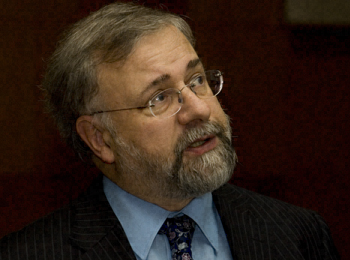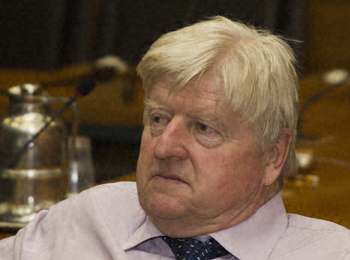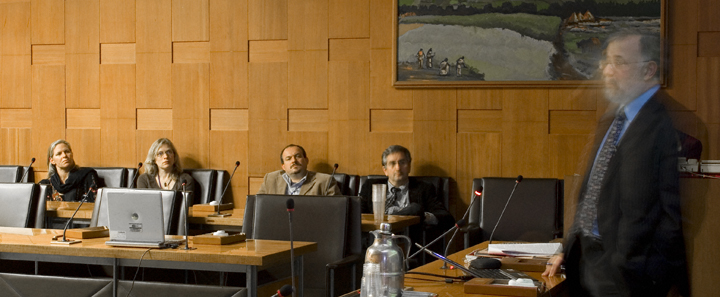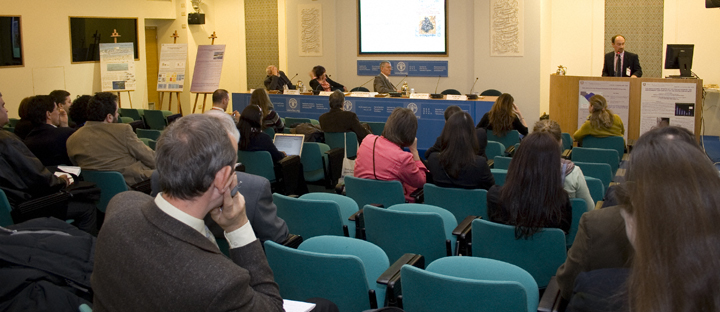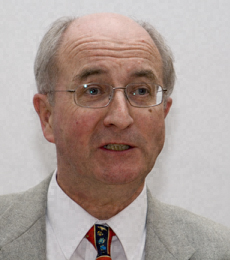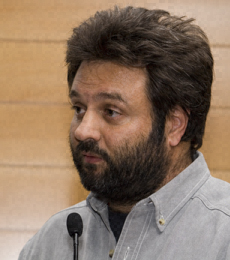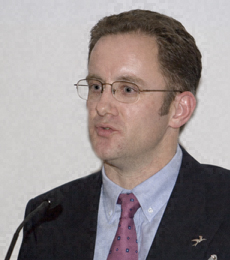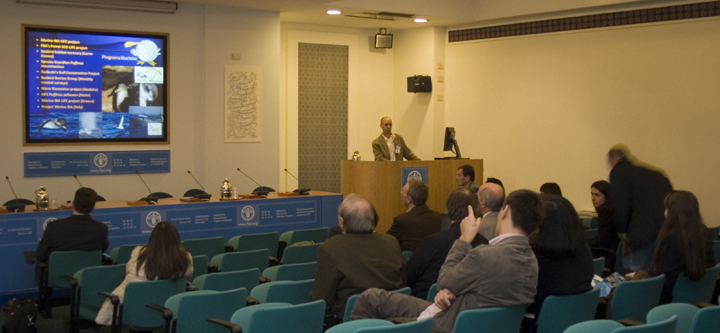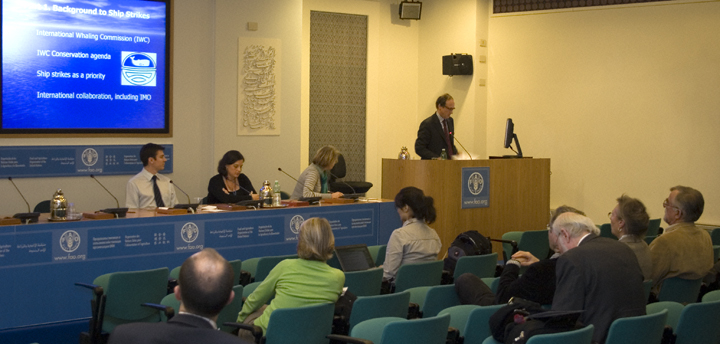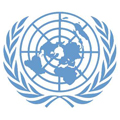

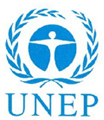


Climate change and cetaceans – New findings and international solutions
Presented by WWF International
Susan Lieberman, WWF International, moderated the event that considered solutions and opportunities to address issues regarding cetaceans and climate change.
Mark Simmonds, Whale and Dolphin Conservation Society (WDCS), addressed the issue of whales and climate change. He said in the marine environment, predicted climate changes will lead to an increase in sea temperature, a rise in sea levels and changes in sea cover. He also noted that changes in habitats and other human impacts related to whales and cetaceans include chemical and noise pollution. Simmonds said the concentration of carbon dioxide is changing ocean acidification, which has unanticipated consequences related to increasing noise pollution, with effects on cetaceans communications. He noted the difficulties in adequately studying highly-mobile animals in the marine environment and stressed that long-term data sets defining marine predators range and habitats are rare. He underscored that an exploration of the links between global climate change and predator responses has just began. Simmonds said that climate change impacts are outside the evolutionary experience of existing cetacean species. He highlighted that major impacts on these animals will affect predator and prey relations and distribution shifts and lead to a decline in the diversity of deep-water cetaceans in relation to temperature. He concluded that theoretical predictions made in the past have been increasingly underpinned by science in the field.
Wendy Elliot, WWF International, focused on the impacts of climate change on whales in the Antarctic. She outlined the research model built to investigate what the Antarctic will look like in the future as a result of climate change. She said the model took into account a global warming of two degrees Celsius by 2042 because an increase of more than two degrees will have irrevocable consequences. She said ice facilitates the production of krill, which is the number one food source for whales, and noted that less ice, means less krill. Elliot underscored the need to reduce emissions, to develop adaptation strategies to help cetacean species to adapt, and to motivate collaborative international efforts. She highlighted the work of NGOs in raising awareness about the impacts of climate change on cetaceans and drew attention to a series of WWF reports available online.
In responding to Lieberman’s question on future actions, Simmonds noted the importance of all UN bodies working together and improving the desperate situations of some species, such as polar bears and cetaceans. Elliot said that with habitat changes, there will be greater opportunities for oil companies and others to expand their activities to areas that were inaccessible before, increasing even further the disturbances of the species and the livelihoods of local communities.
Mark Simmonds <mark.simmonds@wdcs.org>
Wendy Elliot <welliot@wwfint.org>
Intiatives to support migratory species
Presented by the Italian Ministry for Environment, Land & Sea
In his introductory statement, Pierluigi Fiorentino, Ministry of Environment, Land and Sea, Italy, highlighted the activities supported by the ministry relating to the conservation of migratory species.
Marie-Christine Grillo-Compulsione, Executive Secretary of the Agreement on the Conservation of Cetaceans in the Black Sea, Mediterranean Sea and Contiguous Atlantic Area (ACCOBAMS), presented on the activities supported by Italy, highlighting its contributions to, inter alia: a national workshop on by-catch; the preparation of a protocol for data collection on by-catch and depredation in the ACCOBAMS region; capacity building activities, such as “Train the Trainers” workshops; research and monitoring programmes on Swordfish (Xiphius spp.); and awareness raising among children.
Patrick van Klaveren, President of the Pelagos Sanctuary, Monaco, presented the history of the Pelagos project, highlighting Italy’s involvement in the establishment of the process that led to the development of the ACCOBAMS. He noted Italy’s leadership role in spearheading the legal process and said the Sanctuary’s current priorities are whale watching, including a focus on the need for certification and improvement of the scientific research on cetaceans.
Peter Lina, Vice Chair of the Advisory Committee on EUROBATS, on behalf of Executive Secretary Andreas Streit, reported on the development of an agreement on African bats, and noted Italy’s involvement in the EUROBATS negotiations. He presented the organization’s working modalities, and highlighted its 2006 meeting, which was attended by its Scientific Committee and NGOs.
Danilo Russo, EUROBATS Scientific Focal Point for Italy, highlighted the ministry’s work on bats, noting that the country has registered 33 bat varieties, including Sardinian Long-eared Bat (Plecotus sardus) that is unique to Italy. He said 17 bat species are threatened, primarily due to the impact on caves, forest loss, forest management, and agriculture. Russo outlined Italy’s efforts to conserve bats, highlighting: research; attention to “hot” issues such as bats in buildings; rehabilitation; and support to prepare monitoring guidelines and techniques, data storage and legal issues.
Fernando Spina, Institute Superior for Environmental Protection and Research (ISPRA) and CMS COP 9 President, highlighted Italy’s contribution to the flyways across the Mediterranean, focusing on monitoring of migratory birds in Italy. He noted the need for more bird data, and highlighted the importance of bird ringing for data collection. Spina outlined the data collecting activities that have yielded over 4.4 million data in the databank, and nearly 300,000 recoveries of ringed birds. He drew attention to the recently published “Italian Bird Migration Atlas,” and reported the results of studies that demonstrate the effects of climate change on the calendar of migrant birds from sub-Saharan Africa.
Marco Bologna, University of Rome TRE, presented on the ministry’s technical support for the development of the Marine Turtles National Action Plan (PATMA) and related activities, including: a workshop organized on marine turtles; the preparation of evaluation of guidelines for the water assistance and recovery of marine turtles; and a new project to monitor Loggerhead (Caretta caretta), Green (Chelonia mydas) and Leatherback (Dermochelys coriacea) Marine Turtles.
Laura Cerasi, CMS, highlighted the ministry’s support in examining the impact of invasive alien species (IAS) on migratory species. She said the study identifies which migratory species have been, or are most likely to be, affected by IAS, and the measures proposed and adopted to tackle those impacts. Cerasi reported the results of two case studies and a preliminary analysis of the individual species currently included in the CMS Appendices, which found that more than 20% have been affected by IAS, particularly birds, mammals and reptiles, due to direct predation, disease by pathogens and hybridization with native species.
http://www.miniambiente.it
http://www.accobams.org
http://www.gouv.mc
http://www.eurobats.org
http://www.ecoap.unina.it
http://www.infs.it
http://www.uniroma3.it
http://www.cms.int
Pierluigi Fiorentino <fiorentino.pl@miniambiente.it>
Marie-Christine Grillo-Compulsione <mcgrillo@accobams.net>
Patrick van Klaveren <pvanklaveren@gouv.mc>
Peter Lina <phc.lina@tiscali.nl>
Danilo Russo <danrusso@unina.it>
Fernando Spina <fernando.spina@infs.it>
Marco Bologna <bologna@uniroma3.it>
Laura Cerasi <lcerasi@cms.int>
Slender-billed Curlew Challenge
Presented by UNEP and CMS
Presiding over the event to launch the search for the slender-billed curlew (SBC), John O’Sullivan, CMS Scientific Councilor for Birds, said he was privileged to have seen three SBC in his lifetime.
Bert Lenten, Executive Secretary of the Agreement on the Conservation of African-Eurasian Waterbirds (AEWA), announced that in mid-November 2008 AEWA started a project on endangered species. Launching the project, he appealed for support in finding the SBC, and said AEWA would mobilize a network of volunteers in the SBC wintering countries for its search, and expressed interest in designating a bird day for the exercise.
Ward Hagemeijer, Wetlands International, highlighted the organization’s activities on water birds, with support from over 45,000 volunteers, and expressed interest in working with other partners and the volunteers network to find the SBC. He said the organization had started the administrative process of becoming a signatory to the SBC Memorandum of Understanding (MoU).
Marco Zenatello, Instituto Nazionale Fauna Selvetica, highlighted Italy’s past work on the SBC and past international and action plans on the SBC. He speculated the SBC’s sharp decline in the 20th Century was due to habitat loss, poaching and hunting pressure, and said Italy was collaborating with other organizations to cull water birds and search for the SBC. He noted the potential to find it in Libya where it has suitable habitats.
Rob Clay, BirdLife International, on behalf of Executive Director Marco Labertini, noted the organization has a programme on preventing bird extinctions. He said while the natural rate of bird extinction is one bird species per century, 21 birds have become extinct over the past thirty years, and 190 birds species are critically threatened. Clay said the organization plans to identify and match key species guardians with generous individuals to fund work on the SBC.
Robert Hepworth, CMS Executive Secretary, presented the Convention’s SBC conservation measures, under the SBC agreement, which has 18 signatories. He announced that work was under way between the CMS and the Berne Convention on Conservation of European Wildlife and Natural Habitats to have SBC designated as a symbolic species for 2010.
Rob Clay, also discussed the status of the Eskimo Curlew, comparing its status to that of the SBC. He said its last formal documented sighting was in 1963, and suggested it was not extinct, noting a recent reported sighting in 2006 and the poor status of knowledge about it. He urged for immediate action.
Gerard Boere, first Chair of the 1997 SBC Working Group, outlined the history of the Group’s work since 1997. He reported that a seven-person expedition in the Russian Federation following a 1994 sighting lead found enormous habitat changes, which suggested there was more value concentrating on its wintering, over breeding, areas.
Pierre Devillers, Vice Chair of the CMS Standing Committee, speculated that the ongoing rehabilitation of wetlands in Europe could enhance the SBC’s return and argued the SBC is not extinct considering: its opportunistic and nomadic behavior; suitable wetland habitats in Morocco are under-examined; a flock, last sighted in Italy, could not just disappear at one go; and studies show bird migrations are shifting.
Nicola Crockford, Chair of the SBC Working Group, said the group’s top priority was to carry out a comprehensive, coordinated international survey in the non-breeding range, followed by satellite tagging and stable isotope work to help narrow the search of the SBC breeding grounds. She drew attention to a toolkit designed to assist the ornithologists’ search process.
Speakers proposed: examining range maps that could provide leads for surveys; searching in Southeast Asia as the range countries suggest a swing eastwards, as well as in the Middle East and Horn of Africa, as the last sightings were in Oman; encouraging the involvement of birdwatchers in water bird centers; and translating the toolkit documents into local languages and placing them on the website.
http://www.wetlands.org
http://www.infs.it
http://www.birdlife.org
http://www.cms.int
http://www.rspb.org.uk
Ward Hagemeijer <hagemeijer@wetlands.org>
Marco Zenatello <marco.zenatello@infs.it>
Rob Clay <rob.clay@birdlife.org>
Robert Hepworth <rhepworth@cms.int>
Gerard Boere <gcboere@planet.nl>
Nicola Crockford <nicola.crockford@rspb.org.uk>
Pierre Devillers <pierre.devillers@naturalscience.be>
Ship strikes with cetaceans – Solutions for a global issue
Presented by the Belgian Federal Ministry of the Environment, the Government of Australia and the US Government
Els Martens, Agency for Nature and Forests, Belgium, introduced the speakers and moderated the event. She noted the importance of raising awareness on collisions between whales and ships.
Alexandre de Lichtervelde, Belgium Chair of the Ship Strikes Working Group of the International Whaling Commission (IWC), noted that IWC has ship strikes as a priority, and promotes international collaboration on the issue.
Lichtervelde highlighted the standardized global database established by IWC, with a historical register of 763 verified cases. He said the impacts of ship strikes include killed whales, injured crew or passengers, oil spills and other environmental damages. Lichtervelde said mitigation measures are detection, protection and raising awareness. He noted the importance of raising awareness among ship crews, including the distribution of flyers that underscores measures to minimize the risk of collisions between ships and whales. Lichtervelde said reporting on ship strikes is crucial in avoiding new accidents.
Glen Ewers, Department of the Environment, Water, Heritage and the Arts, Australia, outlined that fin whales and humpback whales are the hardest hit by ship collisions. He noted that more than 55% of the collisions result in whales’ death; and most reports involve vessels of 50 meters. Ewers underscored that modeling studies show that an increase in vessel speed increases the risk of lethal injury to whales. He highlighted the need to better understand the factors that contribute to ship strikes, and speculated that the real number of dead or injured whales must be higher than those reported.
Shannon Dionne, National Oceanic and Atmospheric Administration (NOAA), US, focused on the International Maritime Organization (IMO) and national measures. She underscored measures proposed by the US to IMO for mitigating ship strikes, such as a mandatory ship reporting system, traffic separation schemes and seasonal areas to be avoided. Dionne outlined domestic measures taken by NOAA to mitigate ship strikes, including: speed limits for ships, education and outreach activities, and improved research and development. Dionne said the constraints that the measures encounter in the US, include: obstacles gathering data on species and shipping, resistance from the shipping industry and lack of understanding between scientists and the shipping industry.
http://www.iwcoffice.org/sci_com/shipstrikes.htm
http://www.environment.gov.au
http://www.noaa.gov
Alexandre de Lichtervelde <alexandre.delichtervelde@health.fgov.be>
Glen Ewers <glen.ewers@environment.gov.au>
Shannon Dionne <shannon.dionne@noaa.gov>
